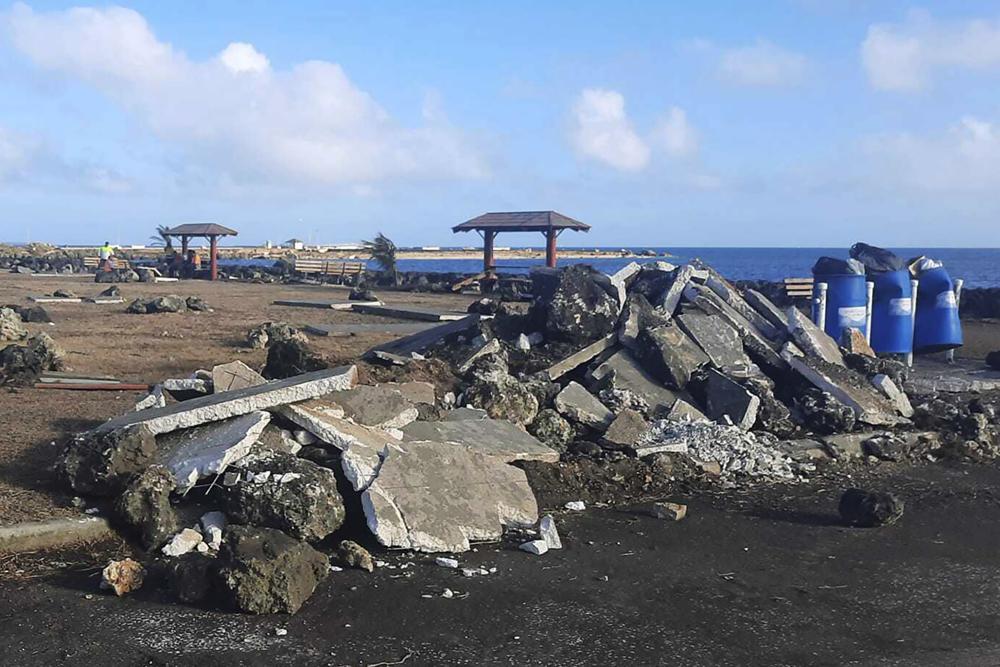Five days after a devastating volcanic eruption and subsequent tsunami uprooted life for the Pacific island nation of Tonga, new pictures and video are starting to pour in, capturing the widespread damage on its main island.

There is still much that is unknown about the state of Tonga’s 170 islands, as Saturday’s events appeared to have broken the single fiber-optic cable that connects Tonga with the rest of the world.
One phone company, Digicel, said Thursday it had managed to restore the ability to make international calls from some places by using a satellite link, but that people would need to be patient due to high demand. It said it hoped to enhance its service over the coming days.
Local journalist Marian Kupu has been sharing photos of damage in the capital city of Nuku’alofa.
Her photos show flattened homes and piles of debris washed up from the tsunami.
The Consulate of the Kingdom of Tonga also shared photos of cars and houses covered in a thick layer of ash, while flattened trees lay on the ground nearby.
Tongan politician, Viliami Latu, shared video of what used to be the Ha’atafu Beach Resort.
The resort also shared photos of what remains of their property.
“Ha’atafu Beach Resort is now unrecognisable and it’s a miracle everyone got out to safety,” they posted to their Facebook page.
Two New Zealand navy vessels will arrive in Tonga on Friday carrying critical water supplies. The amount of ash that was spewed from the volcano has contaminated Tongan water, and scientists say volcanic ash could cause acid rain for months to come.
New Zealand and Australia have also sent military transport planes carrying water containers, kits for temporary shelters, generators, hygiene supplies and communications equipment.
Japan is contributing to the effort as well, sending drinking water and equipment to clear away volcanic ash.
Aid will be a welcome relief, but the Tongan government has asked that supplies be dropped off without contact with Tongan people. The islands have avoided any COVID-19 outbreaks so far, and they do not want a flood of aid workers coming to the island and bringing the virus with them.
Hundreds of homes in Tonga’s smaller outer islands have been destroyed, and at least three people were killed after Saturday’s huge eruption triggered tsunami waves, which rolled over the islands causing what the government has called an unprecedented disaster.
However, there have been some uplifting, inspirational tales to come out of the tragedy.
A 57-year-old Tongan man is now being called a “real life Aquaman” after he survived 27 hours of swimming when he was swept out to sea during Saturday’s tsunami, reports Reuters.
Lisala Folau, who lived on the small, isolated island of Atata which has a population of about 60 people, was swept into the ocean when the waves hit land at about 7 p.m. on Saturday, he said in a radio interview to Tongan media agency Broadcom Broadcasting.
Folau said he was painting his home when he was alerted about the tsunami by his brother, and soon the waves had gone through his lounge.
He climbed a tree to escape but when he got down another big wave swept him away, he said. Folau said he is disabled and cannot walk properly.
“I just floated, bashed around by the big waves that kept coming,” he told the radio station.
Folau said he kept floating, and slowly managed to swim 7.5 kilometres to the main island of Tongatapu, reaching the shore 27 hours later at about 10 p.m. on Sunday.
Meanwhile, Tonga’s infamous shirtless Olympic flagbearer has been working hard to help his country, raising more than half-a-million dollars in relief funds so far.
Pita Taufatofua, 38, set up a GoFundMe page earlier this week, reports CBS News.
“Going forward will be a long hard battle as we try to find ways to creatively meet local needs whilst building up even stronger,” he wrote in an update on Thursday.
“These efforts are going to be a marathon and not a sprint.”
Taufatofua has also been posting to his Instagram account, where he shared that he is waiting to hear from family members that are still unaccounted for on some of Tonga’s smaller islands.
The Hunga Tonga-Hunga Ha’apai volcano erupted with a blast heard 2,300 kilometres away in New Zealand and sent tsunami waves across the Pacific Ocean.
James Garvin, chief scientist at NASA’s Goddard Space Flight Center, said the force of the eruption was estimated to be equivalent to five to 10 megatons of TNT, an explosive force more than 500 times the nuclear bomb dropped by the United States on Hiroshima, Japan, at the end of the Second World War.
– With files from the Associated Press and Reuters
- Canada refused to repatriate woman from ISIS camp because she can’t be arrested: internal memo
- Aw, rats: Chicago’s beloved ‘Rat Hole’ removed from sidewalk
- U.S. tourist faces 12-year sentence for bringing ammo to Turks and Caicos
- Tabloid publisher tells trial he bought, squashed stories damaging to Trump









Comments